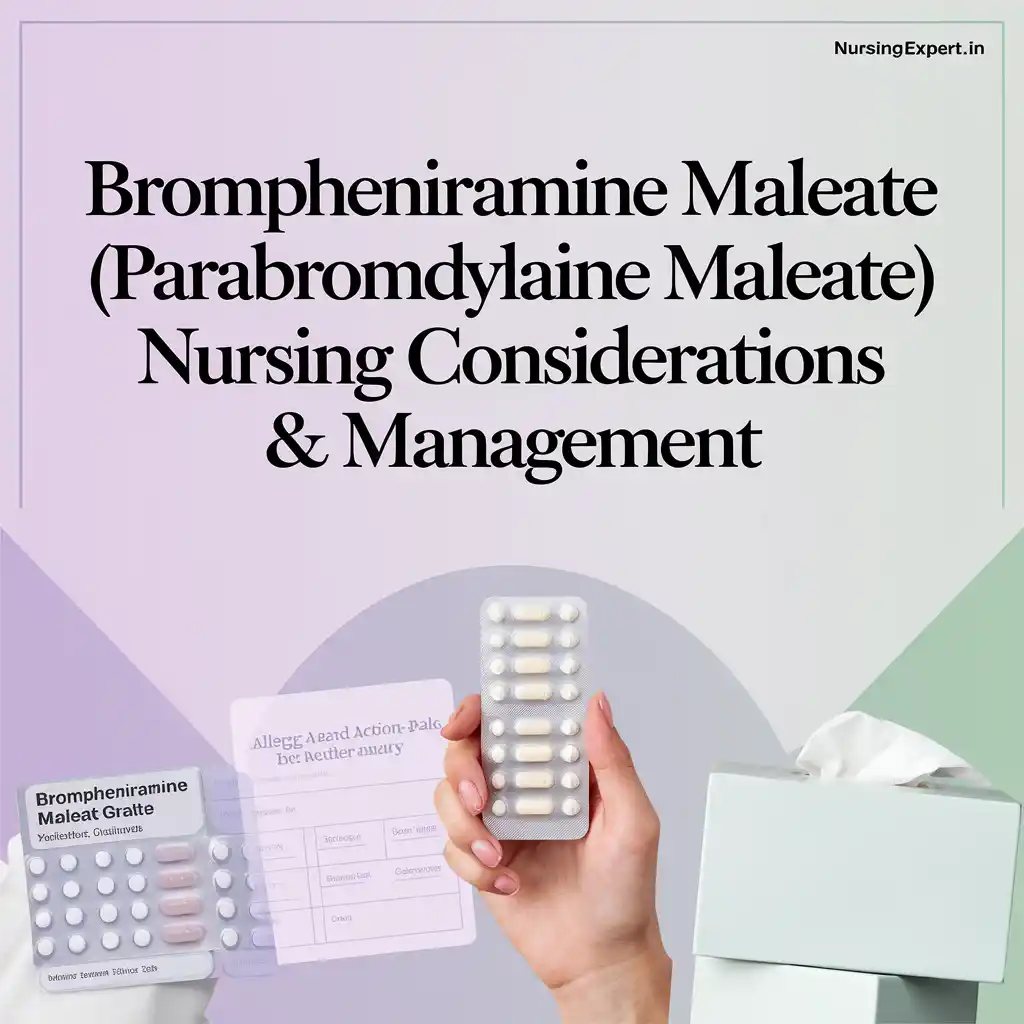Introduction
Brompheniramine maleate, also known as parabromdylamine maleate, is a first-generation antihistamine widely used to manage allergic conditions and respiratory symptoms. As a histamine H1-receptor antagonist, it effectively relieves symptoms such as sneezing, itching, watery eyes, and runny nose associated with allergies and the common cold. In nursing practice, a thorough understanding of its pharmacology, indications, and potential adverse effects is essential for ensuring patient safety and optimizing therapeutic outcomes. This comprehensive guide explores brompheniramine maleate, with a focus on nursing considerations and management strategies to enhance patient care.
Thank you for reading this post, don't forget to subscribe!
Drug Name
- Generic Name: Brompheniramine maleate (parabromdylamine maleate)
- Brand Names: Dimetapp, Lodrane, Bromfed, and others


Dosage & Route
Brompheniramine maleate is available in various formulations, including tablets, capsules, liquids, and injectable solutions. Dosage varies based on patient age, condition, and product used.
- Adults:
- Oral: 4 to 8 mg every 4 to 6 hours; maximum 32 mg/day
- Injectable: 10 mg intramuscularly (IM) or intravenously (IV) every 8 to 12 hours as needed
- Children:
- Oral: 0.125 to 0.25 mg/kg every 6 hours
- Injectable: Rarely used; consult pediatric guidelines
- Route: Oral, IM, IV
Nurses must ensure accurate dosing, particularly in pediatric patients, and confirm the appropriate administration route based on the clinical context.
Therapeutic Actions
Brompheniramine maleate works by competitively blocking histamine at H1 receptors, preventing histamine-mediated responses such as vasodilation, increased capillary permeability, and smooth muscle contraction in the respiratory tract. Its anticholinergic properties contribute to drying nasal secretions but also lead to side effects like sedation and dry mouth.
Indications
- Approved Uses:
- Allergic rhinitis
- Allergic conjunctivitis
- Urticaria and other allergic dermatoses
- Common cold (symptomatic relief)
- Off-Label Uses:
- Motion sickness
- Insomnia (due to sedative effects)
While effective, second-generation antihistamines (e.g., loratadine, cetirizine) are often preferred for their reduced sedation. Brompheniramine may be selected when sedation is beneficial, such as in allergy-related insomnia.
Adverse Effects
Brompheniramine can cause a range of side effects due to its anticholinergic and sedative properties.
- Common Adverse Effects:
- Drowsiness
- Dizziness
- Dry mouth
- Constipation
- Blurred vision
- Serious Adverse Effects:
- Allergic reactions (rash, itching, swelling)
- Difficulty urinating
- Irregular heartbeat
- Seizures (rare)
- Management of Adverse Effects:
- Drowsiness: Advise avoiding driving or operating machinery.
- Dry Mouth: Suggest sugarless gum, candy, or frequent water sips.
- Constipation: Recommend increased fluids, dietary fiber, or a stool softener.
- Serious Reactions: Stop the medication and seek immediate medical attention.
Overdose
Overdose symptoms include severe drowsiness, seizures, widened pupils, and cardiovascular collapse. Management includes supportive care, gastric lavage (if recent ingestion), and activated charcoal. In severe cases, physostigmine may reverse anticholinergic effects under specialist supervision.
Contraindications
- Absolute Contraindications:
- Hypersensitivity to brompheniramine or other antihistamines
- Narrow-angle glaucoma
- Prostatic hypertrophy
- Peptic ulcer disease
- Use in newborns or premature infants
- Concomitant use with monoamine oxidase inhibitors (MAOIs)
- Precautions:
- Asthma or other respiratory conditions
- Cardiovascular disease
- Thyroid disorders
- Elderly patients
- Pregnancy and lactation
Drug Interactions
- CNS Depressants (e.g., alcohol, sedatives, opioids): Increased sedation
- MAO Inhibitors: Risk of hypertensive crisis
- Anticholinergic Drugs: Additive effects (e.g., dry mouth, constipation)
- Certain Antifungals (e.g., ketoconazole): May increase brompheniramine levels
Nurses should review the patient’s medication list and consult with the prescriber or pharmacist if interactions are suspected.
Nursing Considerations
Assessment
- Obtain a complete allergy history, including prior antihistamine reactions.
- Assess symptom severity to confirm brompheniramine’s appropriateness.
- Evaluate for contraindications or precautions (e.g., glaucoma, prostatic hypertrophy).
- Check for drug interactions with current medications.
- In pediatric patients, verify dosage based on weight and age.
Interventions
- Administer as prescribed, ensuring correct dose and route.
- For oral forms, suggest taking with food if gastrointestinal upset occurs.
- Monitor for therapeutic effects (e.g., reduced sneezing, itching).
- Observe for adverse effects, especially sedation, and implement safety measures (e.g., bed rails, ambulation assistance).
- For injectable forms, use aseptic technique and rotate injection sites.
Teaching Points
- Instruct on correct dosage and timing.
- Warn about drowsiness and advise against activities requiring alertness until effects are known.
- Educate on managing dry mouth (e.g., saliva substitutes, oral hygiene).
- Advise avoiding alcohol and CNS depressants.
- For pediatric patients, emphasize accurate dosing and safe storage.
- Instruct to report severe side effects (e.g., difficulty breathing, rapid heartbeat) immediately.
Pharmacokinetics
- Absorption: Well-absorbed orally; onset within 30 minutes to 1 hour.
- Distribution: Widely distributed; crosses the blood-brain barrier, causing CNS effects.
- Metabolism: Hepatic via CYP450 enzymes.
- Excretion: Renal; half-life approximately 25 hours in adults.
This profile guides dosing intervals and highlights risks in renal impairment.
Special Populations
- Pediatrics: Use cautiously; calculate dosage precisely. Avoid in children under 2 years due to serious risks (e.g., respiratory depression).
- Geriatrics: Higher risk of sedation, confusion, and falls. Start with lower doses and monitor closely.
- Pregnancy: Category C; use if benefits outweigh risks (limited data).
- Lactation: Excreted in breast milk; may sedate infants. Consider alternatives or monitor infants.
Patient Case Example
A 35-year-old female with seasonal allergic rhinitis is prescribed brompheniramine 4 mg orally every 6 hours as needed. The nurse assesses for contraindications, noting mild asthma. The patient is educated about drowsiness, advised to take the first dose at home, and instructed to avoid alcohol and report persistent symptoms.
Conclusion
Brompheniramine maleate is a valuable tool for allergy management, but its use demands careful nursing oversight. By assessing patients, administering it safely, monitoring effects, and providing education, nurses ensure optimal outcomes and minimize risks, enhancing patient safety and care quality.


